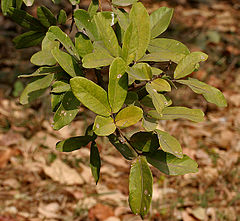| Lifespan: | ⌛ | perennial |
|---|
| Features: | ✓ | evergreen, deciduous |
|---|
|
Sapindus > |
If this plant info box on watering; zones; height; etc. is mostly empty you can click on the edit tab and fill in the blanks!
Sapindus is a genus of about five to twelve species of shrubs and small trees in the Lychee family, Sapindaceae, native to warm temperate to tropical regions in both the Old World and New World. The genus includes both deciduous and evergreen species. Common names include soapberry and soapnut, both names referring to the use of the crushed seeds to make soap.
The leaves are alternate, 15 - 40 cm long, pinnate, with 14-30 leaflets, the terminal leaflet often absent. The flowers form in large panicles, each flower small, creamy white. The fruit, called a soap nut, is a small leathery-skinned drupe 1 - 2 cm in diameter, yellow ripening blackish, containing one to three seeds.
Soap nuts contain saponins, a natural surfactant. They have been used for washing for thousands of years by various peoples, such as the Native Americans.[1] Today, soapberries are being considered for commercial use in cosmetics and detergents, among many other products.[2]
Read about Sapindus in the Standard Cyclopedia of Horticulture
|
|---|
|
Sapindus (Latin, soap and Indian, alluding to use of the fruit as soap in India). Sapindaceae. Soap-Berry. Trees or shrubs, sometimes somewhat climbing, of economic use and sometimes used as ornamentals. Leaves alternate, without stipules, abruptly pinnate or simple, 1-lvd. in one species; the lfts entire, rarely serrate: racemes or panicles terminal or axillary: fls. polygamous, regular; sepals 4-5, in 2 rows; petals 4-5, naked or bearing 1 or 2 glabrous or villous scales above the claw; disk annular; stamens 8-10: berry fleshy or leathery; seeds frequently globose, with a bony testa and no aril, black or nearly so.—About 15 species, tropical regions of the world. The fruit has an alkaline principle known as saponin which makes it useful for cleansing purposes. The fruit was much used in eastern countries before the introduction of soap and is still preferred for washing the hair and cleansing delicate fabrics like silk. The seeds of some species are used for making rosaries, necklaces, and the like. The soapberry trees in cultivation are evergreen or rarely deciduous trees with pinnate, rather large foliage and with terminal large panicles of small whitish flowers followed by berry-like globose orange-brown to black fruits. With the exception of S. Drummondii, which has proved fairly hardy in sheltered positions as far north as Massachusetts, they can be grown in subtropical regions only, but S. Mukorossi is apparently somewhat hardier than the rest. They are sometimes planted for ornament in the southern states and in southern California and some, particularly S. Mukorossi var. carinatus, may possibly be profitably planted for their fruits which are rich in saponin. They do well in rather dry and rocky or sandy soil. Propagation is by seeds which germinate readily and by hardwood cuttings in early spring. CH
|
Cultivation
Propagation
Pests and diseases
Species
The number of species is disputed between different authors, particularly in North America where between one and three species are accepted.
- Sapindus delavayi (China, India)
- Sapindus detergens (syn. var. Soapnut, Ritha)
- Sapindus drummondii (syn. S. saponaria var. drummondii) Western Soapberry (southwestern United States, Mexico)
- Sapindus emarginatus Vahl (Southern Asia)
- Sapindus marginatus - Florida Soapberry (Florida to South Carolina); included in S. saponaria by some authors.
- Sapindus mukorossi Gaertn. - Chinese Soapberry (Southern China west to the Himalayas)
- Sapindus oahuensis Hillebr. ex Radlk. - Lonomea ([[Kauai|KauaTemplate:Okinai]] and [[Oahu|OTemplate:Okinaahu]], Hawaii)
- Sapindus rarak DC. (Southeast Asia)
- Sapindus saponaria L. - Wingleaf Soapberry (southeastern United States, Caribbean, [[Hawaii (island)|island of HawaiTemplate:Okinai]], Central and South America)
- Sapindus tomentosus (China)
- Sapindus trifoliatus L. - South India Soapnut or Three-leaf Soapberry (Southern India, Pakistan)
- Sapindus vitiensis A.Gray (American Samoa, Samoa, Fiji)[3]
Gallery
Sapindus emarginatus soap nut.
References
- ↑ Austin, Daniel F.; P. Narodny Honychurch (2004). Florida Ethnobotany. CRC Press. pp. 601–603. ISBN 9780849323324. http://books.google.com/books?id=eS7lX_rC3GEC.
- ↑ Stoffels, Karin (September 2008). "Soap Nut Saponins Create Powerful Natural Surfactant". Personal Care Magazine (Jeen International Corporation). http://www.personalcaremagazine.com/Story.aspx?Story=4325.
- ↑ http://www.ars-grin.gov/cgi-bin/npgs/html/taxon.pl?33093
- Standard Cyclopedia of Horticulture, by L. H. Bailey, MacMillan Co., 1963
External links
- w:Sapindus. Some of the material on this page may be from Wikipedia, under the Creative Commons license.
- Sapindus QR Code (Size 50, 100, 200, 500)
